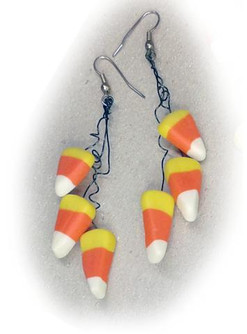
Description
This tutorial is free with the Dolphin Fun Mold. Add the mold first and this will automatically be added to your cart. If you aren't purchasing the Dolphin Fun Mold, please add this tutorial to your cart and check out. You will be emailed a link to open and save the PDF. You will also be able to find it in your account, attached to the order.
Tiny Polymer Clay Bowl with Gold Fish
List of Materials Used:
•Small, oven safe bowl. The bowl used in this tutorial is a glass bowl from Dollar Tree. They were 4 for a dollar. Size of Bowl: diameter 3 1/2" (88mm) - height 1 9/16" (40mm)
•Strong Polymer clay in your choice of colors - about 3 to 4 ounces depending on size of bowl. •• For this bowl I used polymer clay scraps ranging from white and translucent to a blue-gray to turquoise and a tiny bit of Peacock. All the scrap colors were in the turquoise family and were conditioned separately before beginning the project.
•Polymer clay safe work surface. NOTE: be very careful with polymer clay as it can damage fine furniture and painted surfaces. A good choice is a ceramic tile, wax paper, aluminum foil, metal cooking sheet etc.
•Pasta Machine dedicated to polymer clay, Brayer or Acrylic Rolling rod and Poly Clay Play 2mm Depth Guide
•Knitting needle or Penni Jo’s Clay Tools
•Blade
•Tiny fish mold - PJ030 Dolphin Fun
•Mica Powder to color gold fish. I used Perfect Pearls® bronze powder.
•Your favorite clay tools
•Bake 'n Bond® or Poly Paste®
•Optional: •Extruder to make ropes of clay •Chalks •Rubber gloves •Paper towels •Glitter
Basic Polymer Clay Bowl Instructions:
This design was created on the inside of the bowl.
1. Collect about 3 to 4 ounces of scrap clay colors that will go together well. Condition each color well before the next step.
2. Chop up all of the colors using a rigid blade. Mix the colors and chop again until the pieces are about 1/3-to-1/4-inch bits.
3. Roll the chopped clay bits into a ball and compress it with your hand.
4. Using a roller press the ball flat, turning it several times. When the ball is flat enough to go through a pasta machine, put it through, only one time, on the second thickest setting to make a multi-color slab of clay or use a Poly Clay Play 2mm Depth guide.
5. Cut a number of slices from the slab, about 1/8 to 1/4 inch deep as shown
6. Roll several pieces of rope, some longer and some shorter. The longer ones will make larger coils. The shorter ones will be used to make smaller coils to fit around and in between the larger ones.
7. Using the ropes, make a bunch of coils of various sizes.
To make the coils:
A. Begin the coil by curling one end of a rope making a tiny, curled end.
B. Lay the tiny curl on your work surface and, while keeping the coil flat, very gently pull (don't stretch) the loose end of the coil around the coil until reaching the end of the rope. Keep your finger very gently on the coil while wrapping to prevent the coil from forming a cone.
C. Tuck the end up against the coil to finish it.
8. Beginning with the larger coils press them into (or outside) the bowl. Note: To pick up a coil, do not use your fingers as the coil can distort upon lifting. Instead, use a scraper or other blade to lift it from the work surface.
Cover the inside (or outside) of the bowl with ropes beginning with the largest ones filling in spaces with smaller ones. Note: When deciding to use the inside or outside consider this: Using the inside the bowl will make a smaller bowl than using the outside of the bowl and whatever side is touching the bowl will end up smooth.
Do not overlap the coils but put them next to each other so that they just touch. Don't worry about the little spaces between the coils at this time.
9. As you place the coils and they begin to touch each other, you can strengthen the contact by adding tiny bits of Bake 'n Bond® or Poly Paste® on a pointy stick or Peej Pick (from the Penny Jo Tool Kit).
10. Using smaller and smaller coils, fill between the larger coils taking care not to overlap the larger coils. Press gently to your baking form.
11. Fill tiny areas using small slices of rope or tiny balls of clay. Secure with Bake ‘n Bond as needed.
12. Mold 5 tiny fish using translucent clay and the PJ030 Dolphin Fun mold. The fish were molded then dusted with Perfect Pearls® bronze powder. I've discovered that, when using most mica powders, they go onto translucent clay beautifully and keep a rich color. The excess powder was dusted from the fish and then the fish were lifted into place in the bowl of coils. Several dots of Bake 'n Bond® or Poly Paste® were added to hold the tiny fish in place.
13. Bake following the manufacturer's instructions. The polymer clay bowl can be removed when cool.
Finishing. If you have secured the coils where they come together, nothing more should be needed.
Enjoy this tiny treasure. It can hold your favorite earrings, your rings while you lotion your hands, etc. At the office or at work you could hold paper clips, a staple puller, finger covers, a glue stick, thumb tacks, an eraser, etc.
If you want to reinforce some areas or add to the bowl, put the bowl back into the glass bowl in which it was created to support it during successive bakings.
Thanks for stopping by!
Penni Jo Couch
Designer & sculptor of Best Flexible Molds.
Brand
Penni Jo's "Best Flexible Molds"
Description
This tutorial is free with the Dolphin Fun Mold. Add the mold first and this will automatically be added to your cart. If you aren't purchasing the Dolphin Fun Mold, please add this tutorial to your cart and check out. You will be emailed a link to open and save the PDF. You will also be able to find it in your account, attached to the order.
Tiny Polymer Clay Bowl with Gold Fish
List of Materials Used:
•Small, oven safe bowl. The bowl used in this tutorial is a glass bowl from Dollar Tree. They were 4 for a dollar. Size of Bowl: diameter 3 1/2" (88mm) - height 1 9/16" (40mm)
•Strong Polymer clay in your choice of colors - about 3 to 4 ounces depending on size of bowl. •• For this bowl I used polymer clay scraps ranging from white and translucent to a blue-gray to turquoise and a tiny bit of Peacock. All the scrap colors were in the turquoise family and were conditioned separately before beginning the project.
•Polymer clay safe work surface. NOTE: be very careful with polymer clay as it can damage fine furniture and painted surfaces. A good choice is a ceramic tile, wax paper, aluminum foil, metal cooking sheet etc.
•Pasta Machine dedicated to polymer clay, Brayer or Acrylic Rolling rod and Poly Clay Play 2mm Depth Guide
•Knitting needle or Penni Jo’s Clay Tools
•Blade
•Tiny fish mold - PJ030 Dolphin Fun
•Mica Powder to color gold fish. I used Perfect Pearls® bronze powder.
•Your favorite clay tools
•Bake 'n Bond® or Poly Paste®
•Optional: •Extruder to make ropes of clay •Chalks •Rubber gloves •Paper towels •Glitter
Basic Polymer Clay Bowl Instructions:
This design was created on the inside of the bowl.
1. Collect about 3 to 4 ounces of scrap clay colors that will go together well. Condition each color well before the next step.
2. Chop up all of the colors using a rigid blade. Mix the colors and chop again until the pieces are about 1/3-to-1/4-inch bits.
3. Roll the chopped clay bits into a ball and compress it with your hand.
4. Using a roller press the ball flat, turning it several times. When the ball is flat enough to go through a pasta machine, put it through, only one time, on the second thickest setting to make a multi-color slab of clay or use a Poly Clay Play 2mm Depth guide.
5. Cut a number of slices from the slab, about 1/8 to 1/4 inch deep as shown
6. Roll several pieces of rope, some longer and some shorter. The longer ones will make larger coils. The shorter ones will be used to make smaller coils to fit around and in between the larger ones.
7. Using the ropes, make a bunch of coils of various sizes.
To make the coils:
A. Begin the coil by curling one end of a rope making a tiny, curled end.
B. Lay the tiny curl on your work surface and, while keeping the coil flat, very gently pull (don't stretch) the loose end of the coil around the coil until reaching the end of the rope. Keep your finger very gently on the coil while wrapping to prevent the coil from forming a cone.
C. Tuck the end up against the coil to finish it.
8. Beginning with the larger coils press them into (or outside) the bowl. Note: To pick up a coil, do not use your fingers as the coil can distort upon lifting. Instead, use a scraper or other blade to lift it from the work surface.
Cover the inside (or outside) of the bowl with ropes beginning with the largest ones filling in spaces with smaller ones. Note: When deciding to use the inside or outside consider this: Using the inside the bowl will make a smaller bowl than using the outside of the bowl and whatever side is touching the bowl will end up smooth.
Do not overlap the coils but put them next to each other so that they just touch. Don't worry about the little spaces between the coils at this time.
9. As you place the coils and they begin to touch each other, you can strengthen the contact by adding tiny bits of Bake 'n Bond® or Poly Paste® on a pointy stick or Peej Pick (from the Penny Jo Tool Kit).
10. Using smaller and smaller coils, fill between the larger coils taking care not to overlap the larger coils. Press gently to your baking form.
11. Fill tiny areas using small slices of rope or tiny balls of clay. Secure with Bake ‘n Bond as needed.
12. Mold 5 tiny fish using translucent clay and the PJ030 Dolphin Fun mold. The fish were molded then dusted with Perfect Pearls® bronze powder. I've discovered that, when using most mica powders, they go onto translucent clay beautifully and keep a rich color. The excess powder was dusted from the fish and then the fish were lifted into place in the bowl of coils. Several dots of Bake 'n Bond® or Poly Paste® were added to hold the tiny fish in place.
13. Bake following the manufacturer's instructions. The polymer clay bowl can be removed when cool.
Finishing. If you have secured the coils where they come together, nothing more should be needed.
Enjoy this tiny treasure. It can hold your favorite earrings, your rings while you lotion your hands, etc. At the office or at work you could hold paper clips, a staple puller, finger covers, a glue stick, thumb tacks, an eraser, etc.
If you want to reinforce some areas or add to the bowl, put the bowl back into the glass bowl in which it was created to support it during successive bakings.
Thanks for stopping by!
Penni Jo Couch
Designer & sculptor of Best Flexible Molds.
Brand
Penni Jo's "Best Flexible Molds"
Product specs & benefits.
Free Cutter Offer
Love a surprise? Swing by every week to see what fun freebie drops on Friday! You never know what crafty treat might come your way!
Every order placed on Friday (CST) automatically includes the Friday Freebie—no code needed! Plus, share a photo of what you create and you could be entered into our quarterly drawing for more free stuff. Let the fun begin!
Shop now










